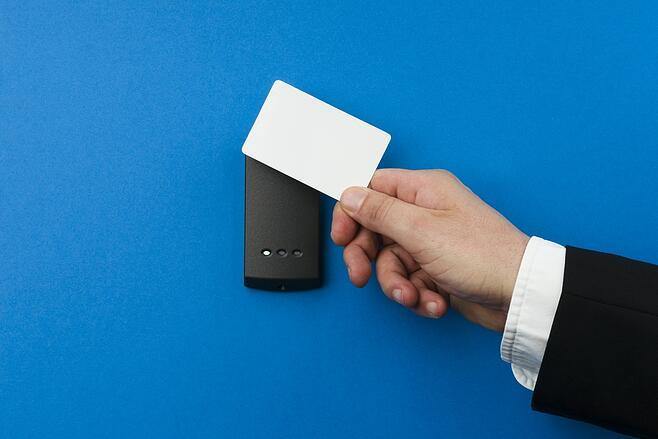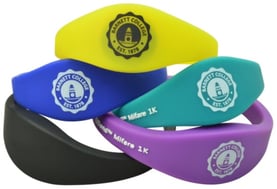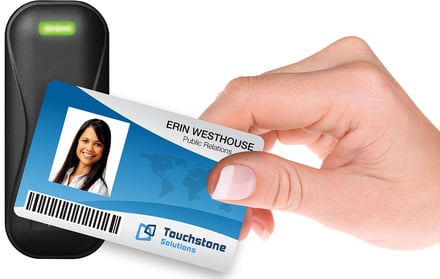- No products in the cart.
Open Up: Should You Use Access Cards, Key Fobs or Access Wristbands?
14
Jun
In today's office buildings, factories and schools, physical keys are becoming a thing of the past.
Sure, keys still exist and will always be used in certain places. Some organizations are a little resistant to change, while others may lack the necessary room in the budget to overhaul an access control system.
However, access credentials are becoming more and more common, as swipe/scan cards, wristbands and fobs are replacing physical keys in more and more locations.
The reasons behind these changes vary from place to place, but most organizations switch to access credentials because they're easier to manage and offer increased control over security at a site.
When it comes to choosing a modern access credential solution, you have three real options: access cards, access wristbands and access key fobs.
All three options perform similar tasks, namely interacting with card readers to unlock doors. Both allow an organization to introduce a more modern security solution to a site at a reasonable cost.
There are also clear differences between the three solutions that will almost always make one option clearly better than the other two when it comes to meeting a site's specific needs.
How will you open your doors?
Before getting into the specifics of which solution is best for a given situation, it's important to understand what we mean by cards, wristbands and key fobs.
While these credential solutions may be obvious to some, other people aren't going to be as familiar.
What do we mean by access cards, access wristbands and access key fobs?
- Access cards are ID cards that contain some kind of internal technology, usually a proximity chip or a MIFARE® smart chip. These chips interact with a card reader to perform a predetermined function. Access cards normally look like standard ID cards, but are occasionally a little thicker.
- Access key fobs are small plastic discs that contain internal technology. Fobs normally use proximity technology, though there are MIFARE® discs and tags available. Most fobs are similar in size to a poker chip.
- Access wristbands (right) are silicone rubber wristbands that contain a proximity or a MIFARE® chip. The wristbands are designed to be worn all day and to either take the place of a card/fob, eliminating the need for a card accessory, or to supplement a card/fob solution.
Now that you know a little bit more about each credential style, let's discuss which you should choose as your next access control credential.
When should you use access cards?
- If photo ID is important to your organization, access cards are really the only choice. For small organizations, a photo ID card may not be necessary: everyone knows everyone, making it easy to tell if an unauthorized person is on site. However, for large, security-focused organizations, photo ID is a must. If that's the case, you should choose access cards, as wristbands and fobs don't offer any kind of identity verification.
- If you want your credentials to interact with more than one kind of reader, an access card is your best bet. For example, you use a proximity card reader to get into your building and a barcode scanner to sign into your attendance system. A fob or wristband won't work with the barcode scanner, while a proximity card with a barcode printed on it will work with both.
- If you already have an ID card printer and supplies, it's probably more cost-effective to use access cards. Purchasing this equipment is often one of the biggest barriers to entry for those looking at an access card solution. Also, switching to fobs or wristbands could render this equipment useless, which isn't a great use of resources.
When should you use access key fobs?
- If you're looking for something understated and subtle that just gets the job done, key fobs are a good solution. They're small, discreet and don't require much to be worn; just throw them on an existing key chain. Unlike ID cards, which are designed to draw attention, key fobs are a plain, under-the-radar solution.
- If you work for a secure organization that doesn't want employee names or photos out for public consumption, key fobs can be a good idea. Some organizations may have security reasons for not wanting the public to know an employee's name or title, making an ID card impractical. In these situations, a blank access card can work, but a key fob may be a more convenient solution.
- If you don't want to invest in additional supplies and equipment, key fobs are your best bet. A nice, custom-printed access card may be a professional option, but creating them requires either having them custom-made by an outside vendor or purchasing an ID card printer, printer supplies and photo ID software. If you'd prefer something you can just order and issue, go with key fobs.
When should you use access wristbands?
- If you work in an active industry and need a credential that stays out of the way, access wristbands will get the job done. Unlike access cards or key fobs, which need to be worn on a lanyard, badge reel or key chain, access wristbands sit comfortably on the wrist. This prevents worries about tangles and snares, allowing employees to move about freely.
- If you're looking for the most eye-catching solution, access wristbands fit the bill. They're a sleek, modern credential, one that definitely gets attention. With a number of different colors available, it's not hard to choose and customize an access wristband that will really get your brand out there.
- If your credential will face a lot of exposure to the elements, wristbands are a good choice. Made of silicone rubber, our UBand™ wristbands are waterproof and sweatproof. Key fobs can also work in the elements, but are easier to lose due to their small size. Access wristbands will remain securely on the user in even the most slippery or wet conditions.
Access wristbands, access cards and access key fobs are great solutions for businesses, schools, factories and other organizations looking to move away from physical keys. If you're interested in adding any of these access credentials to your site, let us know.
We'll work with you to discuss your options, recommend technology formats and more.

 USA
USA




